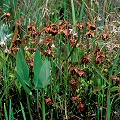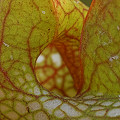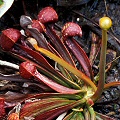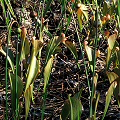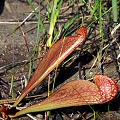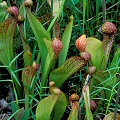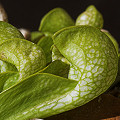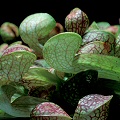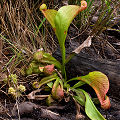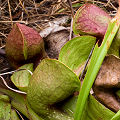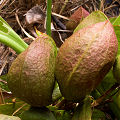Q: About Sarracenia psittacina, the parrot pitcher plant
A: Sarracenia psittacina is the most deviant plant in the genus.
By that, I mean that it really breaks in form from the others, and has a completely different pitcher shape and trapping strategy.
Its genus name refers to the fact that its globose head looks like the head of a psittacine (parrot). This is also the origin
of its most frequently used common name.
Sarracenia psittacina is a small plant that usually keeps its pitchers tightly against the ground
in a flat, prostrate rosette. The pitcher tubes are horizontal. The pitcher mouth is no longer a large, gaping hole. Instead,
the pitcher lid is dramatically modified, and the pitcher mouth is transmogrified into
a tunnel allowing access to a large, roughly globose
chamber. Once an insect crawls into the pitcher, the exit path is hard to return to. Meanwhile, the horizontal pitcher tube
seems to promise escape but is actually a one-way trip into an increasingly narrow tube with hairs that prohibit escape.
The entire plant is brightly pigmented to attract prey. To help encourage prey to wander into the trap, the globose pitcher
top is adorned with light-transmitting fenestrations. Also, the pitcher ala is expanded into a large, vertical wall that directs
crawling insects into the trap opening.
Since the trapping system is so different from other Sarracenia, this plant is considered a
"lobster pot" carnivore instead of a pitfall trap. Incidentally, this kind of trap would function even if submerged,
and since the plant may be submerged during floods it is often suggested that it functions as an aquatic hunter during such
times. Certainly, Schnell (2002) noted the capture of "water bugs" during floods.
Strangely, S. psittacina quite often produces leaves that are semi-erect. Also, the leaf ala is
sometimes extremely reduced. I have no explanation for such behaviors.
Varieties
Sarracenia psittacina var. psittacina
This is the normal form of the plant. The flower is red, and the pitchers are variously pigmented. Some are mostly green with red
venation, others are deeply flushed red throughout. A completely anthocyanin-free variant (obviously, with green flowers), has been
described with the name
S. psittacina var. psittacina f. viridescens. This is
the same plant as something described by horticulturists under the cultivar name
S. psittacina 'Green Rosette.' It has been found in Alabama (Baldwin County) and Florida (Gulf County),
and reportedly other areas in Florida.
Another Florida specimen from Bay County supposedly has normally pigmented leaves, but yellow flowers. By their description, I am not sure
if the discoverers actually meant to indicate a plant with normal leaves but green flowers. I would be interested in hearing if this
plant is still in cultivation! I have grown a few plants that were purported to have yellow or even orange flowers, but in
my cultivation they produced regular red flowers. I am confident these are just mix-ups in cultivation.
Sarracenia psittacina var. okefenokeensis
Much like Sarracenia minor var. okefenokeensis, this plant is
characterized by relative gigantism. However, unlike that other variety, this plant is not restricted to the Okefenokee Swamp and
immediate region--it has been found in Apalachicola National Forest, and Eglin Air Force Base. Indeed, the largest plant I ever saw was
in Bradwell Bay Wilderness Area, Wakulla County, Florida. It was huge!
Generally speaking, if the pitcher is longer than about 30 cm, it is var. okefenokeensis. Plants with
shorter leaves may still be the variety, if the pitcher length (measured from leaf base at rhizome to the crown of the pitcher dome),
divided by the width of the pitcher dome (at greatest width) is about 2.6 (ranging 2.4-2.8) it is
okefenokeensis. If this ratio is 4.3 (ranging 3.7-5.1), it is
var. okefenokeensis.
This variety also often sports very large, semicircular wings. The pitchers may also have decreased amounts of areolation.
A completely anthocyanin-free variant has been
dubbed with the name
S. psittacina var. okefenokeensis f. luteoviridis.
Now that is something I'd like to see! I have to head back to Okefenokee Swamp!
There are other coloration varieties of this plant, but none have been given names. Some of these are deeply red
throughout,
others have very little red pigmentation. Some plants have an orangelike cast to them. In Gulf county (Florida), plants have been
detected that are "veinless" and "semi-veinless" (terminology I describe more on the
FAQ page on S. purpurea). These might be more
of the var. okefenokeensis plants.
Range
States: Georgia, Florida, Alabama, Mississippi, Louisiana. (Reports for South Carolina are anecdotal.)
In the wild, S. psittacina occurs in Georgia; the Florida panhandle; and the Gulf Coast from Alabama and
Mississippi to a tiny bit of far eastern Louisiana (St. Tammany and Tangipahoa Parishes). Reports for it in central
Louisiana are apparently bogus. There are records of it in eastern Florida (Nassau and Baker Counties), near where the
Okefenokee Swamp borders on the state; I have seen collections from Nassau County made in 2000 (FSU), but I do not know if
it still exists in Baker County.
The conservation challenges facing S. psittacina are the same as those facing the rest of the genus
Sarracenia: habitat destruction and degradation. Since it is so short it can escape the blades of
the mowing equipment used on road edges; I have seen it growing well in mow strips in the Florida panhandle where other
Sarracenia had been extirpated.
Page citations:
Kartesz, J. et al. 2009 (BONAP); Mazur, C.J. & Lechtman, J. 2005; McDaniel, S. 1971;
McPherson, S. & Schnell, D. 2011;
Rice, B.A. 2006a; Schnell, D.E. 2002a; Sheridan, P. & Scholl, B. 1993.
